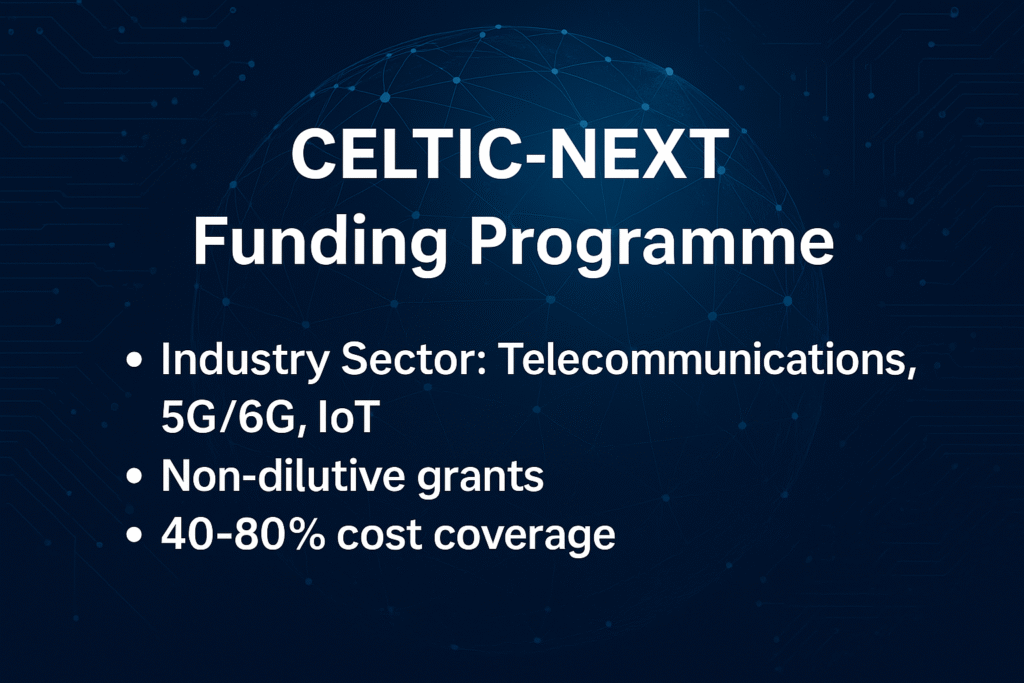CELTIC‑NEXT Funding Programme, the Eureka Cluster devoted to secure and sustainable next-generation communications, opens two non-dilutive grant calls every calendar year—one in spring and one in autumn. The current Spring window runs 1 January – 25 April . Grants of 40 – 80 % of eligible R&D costs are available via each partner’s national innovation agency; typical project sizes range from €1 million to several million. The repeatable, twice-yearly cadence allows boards and CTOs to align multi-year technology roadmaps with dependable funding opportunities.
1. CELTIC‑NEXT Funding Programme Snapshot
| Instrument | Eureka Cluster grant (non-repayable, non-equity) |
| Recurring Rhythm | Spring call (Jan – Apr) & Autumn call (Jul – Oct) every year |
| Sector Focus | 5G/6G, open RAN, AI-driven networks, IoT, quantum & photonic communications, cyber-secure cloud/edge |
| Consortium Minimum | ≥ 2 independent entities in ≥ 2 Eureka countries |
| Funding Intensity | 40 – 80 % of eligible costs, highest rates for SMEs & research bodies |
| Key 2025 Dates | Launch webinar 15 Jan • Brokerage Day Barcelona 24 Feb • Deadline 25 Apr • Labels mid‑Jun |
2. Why the Recurring Cycle Matters
- Strategic timing – Firms can slot successive work‑packages into alternating calls (e.g., fundamental research in Spring, pilot deployment in Autumn).
- Pipeline certainty – Missed this round? The next opens 1 July 2025 and, barring policy upheaval, the same cycle is already pencilled in for 2026.
- Budget planning – Finance teams can synchronise national co‑funding commitments with annual cap‑ex cycles.
- Talent retention – Recurring calls support continuous funding streams, reducing project “cliff‑edge” risk for specialised engineers.
3. Eligibility & Project Fit for CELTIC‑NEXT Funding Programme
Organisation types
- SMEs & start‑ups (highest funding percentages)
- Large corporates
- Universities & research institutes
- Public bodies with civil-scope projects
Thematic alignment
Projects must push the state‑of‑the‑art in connectivity—core radio, optical backhaul, satellite‑NTN, network slicing, edge AI, secure orchestration, or sectoral demonstrators (connected mobility, e‑health, smart grids).
4. Financial Architecture
| Funding model | Cost‑reimbursement grant; non‑dilutive |
| Cash flow | Mobilisation 10–20 % → milestone tranches → retention after audit |
| Stackability | Private cash or other regional incentives permissible if costs are not double‑funded |
| Typical aid intensities | SMEs 60–80 %, large enterprises 40–60 % (country‑specific) |
5. Winning‑Proposal Playbook
- Consortium design: Secure complementary expertise across at least two countries; avoid any partner > 70 % budget share.
- Technical leap: Quantify KPIs that beat today’s benchmarks (latency, throughput, energy/bit, TCO).
- Market traction: Include LoIs from pilot customers or standards bodies; map 18‑ to 36‑month road to commercial launch.
- Risk governance: Cover spectrum, standards, supply‑chain, and regulatory risks with contingencies.
- Budget hygiene: Mirror work‑package effort; back large CapEx with vendor quotes.
6. Evaluation Grid
- Innovation & Technical Merit — 40 %
- Implementation & Consortium Quality — 30 %
- Market Potential & Impact — 20 %
- Sustainability & Digital Inclusion — 10 %
CELTIC‑NEXT Funding Programme Common rejection triggers: incremental R&D, over‑dominated consortium, vague exploitation plan, missing national annexes.
7. Board‑Level Benefits
- Capital efficiency — Up to 80 % public funding with zero equity dilution.
- Standards influence — Cluster participation positions firms to shape EU 6G and AI‑network regulations.
- Global channels — Partners across 45 + countries create early‑adopter networks and export footholds.
- Valuation uplift — Eureka labels are a strong validation signal for strategic investors.
8. Action Timeline
| Internal go/no‑go & budget gate | Before 15 Jan 2025 |
| Attend launch webinar | 15 Jan 2025 |
| Brokerage Day (partner hunt) | 24 Feb 2025 |
| Freeze consortium & WPs | Mid‑Mar 2025 |
| Submit CPP + national annexes | 25 Apr 2025 23:59 CET |
Prepare for Autumn back‑up call – From 1 Jul 2025
Disclaimer
Funding rules vary by country. Verify eligible cost categories and aid ceilings with your National Funding Body before finalising budgets.
For tailored support—financial modelling, consortium matchmaking, or red‑teaming your proposal—contact our advisory desk.
9. Advisory Perspective
CELTIC‑NEXT Funding Programme as one of the most capital‑efficient instruments in the European toolbox for telecommunications and deep‑tech connectivity companies at TRL 3‑6. Its twice‑yearly cadence offers planning certainty, and the cluster format encourages multi‑country market access while spreading technical risk.
That said, competition has intensified since 2023; overall success rates hover around 30–35 percent in many countries. Proposals that cannot show a >20 percent performance delta versus EU state‑of‑the‑art benchmarks or lack a compelling exploitation partner are unlikely to clear the bar. Dual‑level administration—cluster and national—adds process friction, so project management overhead should not be underestimated.
For SMEs, CELTIC‑NEXT’s grant intensity (up to 80 percent) beats most national R&D schemes and avoids equity dilution. For large corporates, the value lies more in ecosystem building, standards influence, and risk‑sharing than in the absolute euro amount. Our recommendation is to pair CELTIC with either an EIC Transition or Horizon Europe Innovation Action in later stages to bridge pilot‑to‑market gaps.
SWOT Snapshot
| Strengths | Weaknesses |
| • Non‑dilutive grants • High aid intensity for SMEs • International consortium opens new markets • Influence on 6G standards |
• Administrative complexity (dual submission) • Lower funding rates for large firms • ICT‑centric scope |
| Opportunities | Threats |
| • Surge in 6G/NTN funding 2024–28 • Edge‑AI and quantum networking niches • Alignment with Chips Act & Digital Decade |
• National budget cuts could lower aid ceilings • Heightened competition (≈30 % success rate) • Geopolitical supply‑chain constraints |




